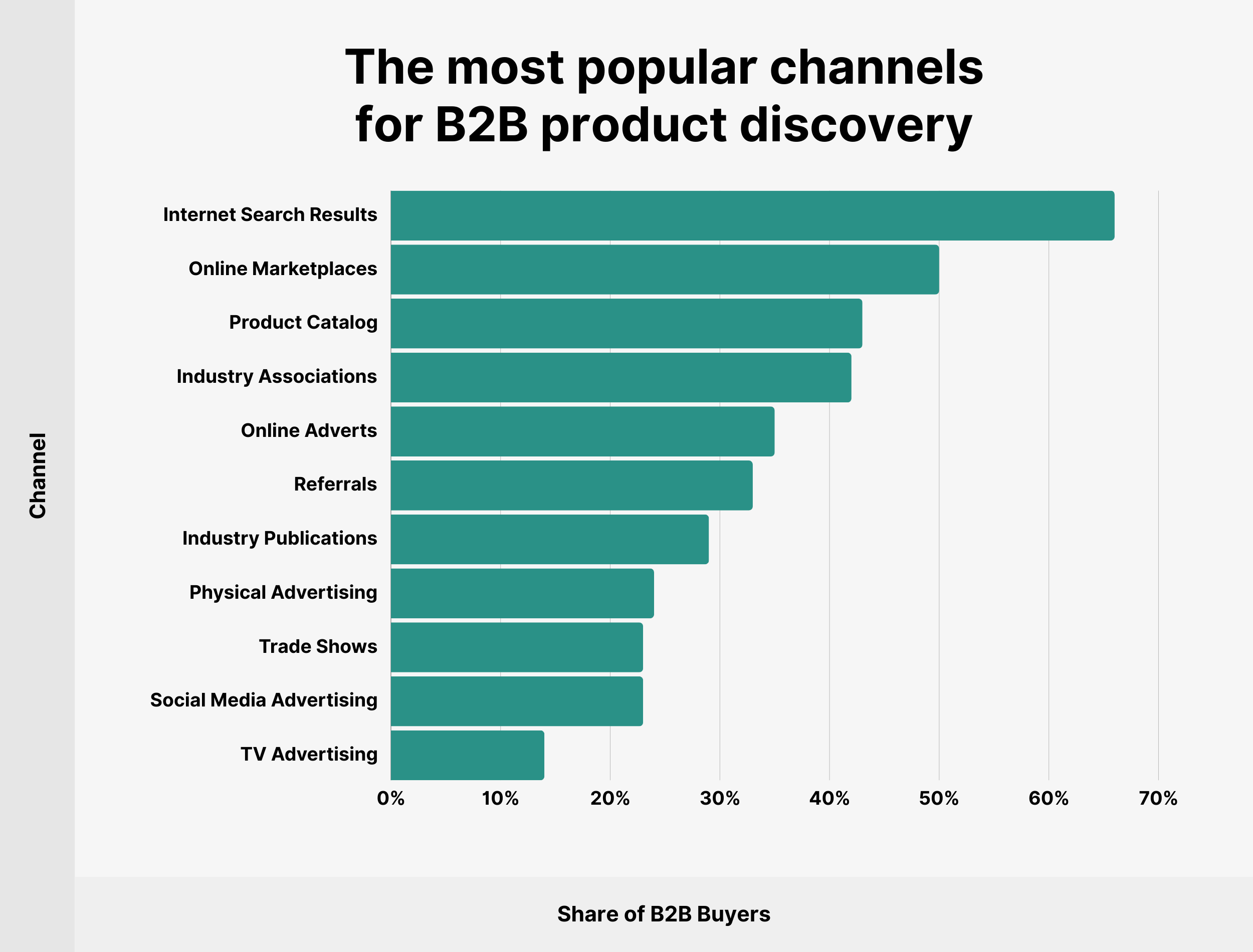B2B SEO has become an important element of a successful marketing strategy, helping B2B businesses improve their online visibility and credibility.
In this post, you’ll find 10 up-to-date B2B SEO statistics for 2024.
Let’s dive right in!
Internet search results are the primary source for product discovery among B2B buyers in the US (Statista)
66% of B2B buyers turn to internet search results when exploring products they plan to buy, rather than relying on industry publications or relevant trade shows.
Here’s a complete breakdown of the most popular channels for B2B product discovery:
Channel
Share of B2B Buyers
Internet Search Results
66%
Online Marketplaces
50%
Product Catalog
43%
Industry Associations
42%
Online Adverts
35%
Referrals
33%
Industry Publications
29%
Physical Advertising
24%
Trade Shows
23%
Social Media Advertising
23%
TV Advertising
14%
SEO is the most used marketing tactic among B2B companies (Sagefrog)
Among surveyed B2B marketers, 49% of respondents claim to implement SEO in their marketing strategy, more than any other tactic. Content marketing and organic social media remain a priority for B2B businesses.
Here’s a complete breakdown of the most implemented marketing tactics among B2B marketers:
Marketing Tactic
Share of B2B Marketers
Search Engine Optimization (SEO)
49%
Content Marketing
43%
Organic Social Media
43%
Email Marketing
36%
Paid Social Media
35%
In-Person Tradeshows & Events
35%
Virtual Events & Webinars
28%
Search Engine Marketing (SEM)
27%
Public Relations
27%
Video Marketing
21%
Direct Marketing
20%
Telemarketing
20%
Print Advertisements
12%
B2B organizations allocate 15% of their marketing spend to SEO (Sagefrog)
B2B organizations spend around 15% of total marketing spend on SEO, that’s more than on AI chatbots (12%) or video marketing (9%)
Here’s a table with the top areas of marketing spend among B2B companies:
Channel
Share of Marketing Spend
In-Person Tradeshows and Events
25%
Direct Marketing
23%
Content Marketing
23%
Directories and Sponsorships
23%
Print Advertisements
22%
Public Relations
21%
Paid Social Media
21%
Email Marketing
20%
Branding
20%
Marketing Technology
17%
Search Engine Marketing
17%
Search Engine Optimization
15%
Virtual Events and Webinars
15%
AI Chatbots
12%
Video Marketing
9%
Market Research
9%
Website Development
8%
23% of B2B marketers claim organic search is the most effective channel for driving revenue (Wpromote)
Organic search ranks among the most effective revenue-driving marketing channels, behind display advertising (36%) and paid search (32%).
Here’s a complete breakdown of the most effective B2B marketing channels for driving revenue:
Channel
Share of B2B Marketers
Social Media
60%
Content Marketing
49%
Email
45%
Display Advertising
36%
Paid Search
32%
Organic Search
23%
Streaming TV (CTV, OTT)
23%
19% of B2B marketers say SEO contributes the most to achieving top-of-funnel goals (Wpromote)
When it comes to the most effective marketing tactics for achieving top-of-funnel goals (boosting brand awareness and generating leads), 19% of marketers say that’s SEO, more than podcasts (16%) or converged TV (11%).
Here’s a comprehensive overview of effective tactics for achieving top-of-funnel goals:
Tactic
Share of B2B Marketers
Social Media
50%
Email
43%
In-Person / Live Events
34%
Video
30%
Interactive Content
30%
Influencer Marketing
30%
Paid Search
28%
Site Content
26%
Direct Mail
24%
Virtual Events
23%
Account-Based Marketing
22%
SEO
19%
Podcasts
16%
Converged TV
11%
17% of B2B marketers consider SEO as a key contributor to achieving bottom-of-funnel goals (Wpromote)
SEO is a key element of the marketing mix in achieving bottom-of-funnel goals, according to 17% of surveyed marketers. Social media and email remain the most effective bottom-funnel channels.
Tactic
Share of B2B Marketers
Social Media
46%
Email
40%
Paid Search
30%
In-Person / Live Events
30%
Direct Mail
28%
Video
27%
Interactive Content
26%
Influencer Marketing
25%
Virtual Events
23%
Account-Based Marketing (ABM)
22%
Site Content
21%
Podcasts
18%
SEO
17%
Converged TV
14%
67.6% of organic online traffic clicks originate from the top five organic search results (Gartner)
SEO is a key element in the marketing mix for B2B businesses. The first five organic results account for 67.6% of organic online traffic clicks. By securing an organic placement among these top results, a B2B company can enhance its visibility and improve overall marketing performance.
B2B buyers spend 27% of their time in the purchase journey on online research (Gartner)
B2B buyers spend nearly one-third of their time on the purchase journey on online research, which may include using at least one search engine.
Marketing teams need to align B2B SEO strategy with the buyer purchase journey. And create relevant content to match buyer needs.
Only 3% of B2B content generates external links from multiple websites (Backlinko)
An analysis of 912 million blog posts shows that the vast majority (93%) of B2B content generates no external links. Only 3% of B2B content gets linked to multiple websites.
Organic search is a key lead source (Sagefrog)
According to 15% of B2B marketers, organic search is a key sales and marketing lead source, behind referrals (17%) and account-based marketing (17%).
Here’s a complete breakdown of top lead sources according to B2B marketers:
Lead Source
Share of B2B Marketers
In-Person Tradeshows and Events
33%
Email Marketing
32%
Directories and Sponsorships
32%
Print Advertisements
27%
Direct Marketing
26%
Paid Social Media
24%
Public Relations
24%
Virtual Events and Webinars
21%
Referrals
17%
Account-Based Marketing
17%
Organic Search
15%
Networking
12%
Search Engine Marketing
12%
Telemarketing
9%
Conclusion
That’s it for my list of B2B SEO statistics in 2024.
I hope you find them useful.
The post 10 B2B SEO Statistics appeared first on Backlinko.



